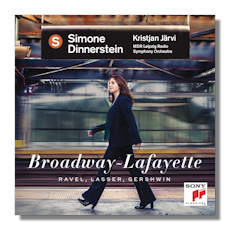
The Internet's Premier Classical Music Source
Related Links
-
Gershwin Reviews
Ravel Reviews - Latest Reviews
- More Reviews
-
By Composer
-
Collections
DVD & Blu-ray
Books
Concert Reviews
Articles/Interviews
Software
Audio
Search Amazon
Recommended Links
Site News
 CD Review
CD Review
Broadway-Lafayette

- Maurice Ravel: Concerto for Piano in G Major
- Philip Lasser: Concerto for Piano "The Circle and the Child"
- George Gershwin: Rhapsody in Blue
Simone Dinnerstein, piano
MDR Leipzig Radio Symphony Orchestra/Kristjan Järvi
Sony Classical 8887-503245-2 68:36
It is good to see Simone Dinnerstein taking up recent American music. In December 2014 I attended her premiere performance with the Chiara String Quartet of Jefferson Friedman's appealing Piano Quintet, The Heart Awakes Into at the Library of Congress (commissioned by the Irving and Verna Fine Fund for the Irving Fine Centennial Festival.) Dinnerstein paused to make some prepared piano adjustment for one section of that. I would have reviewed this performance, but I had not been prepared to take notes on the occasion.
Now, Dinnetstain brings us the recorded premiere of a work commissioned for her in 2013, Philip Lasser's piano concerto with the unusual and somewhat puzzling title, The Circle and the Child. Dinnerstein gives it the outstanding performance on the present recording. Lasser's work has a connection with Dinnerstein's interest in the works of Bach, which she has recorded on half a dozen CD releases. In the present case, it is a chorale, Ihr Gestirn', ihr hohen Lüfte (You Stars of heaven, you vaulted sky), which Lasser says "weaves like a profound harmonization through its small frame. Like an exquisite perfume, his chorale emanates from every passage of my concerto. One hears the chorale as an intimate confession from the piano in dialogue with itself and its orchestral double through the fears and loves of a child." He glosses this remark by saying that "rather than having distinct parts as in a play, the orchestra and piano share the same role and travel together through the same soundscape…As in a hologram, the orchestra casts a three-dimensional world around the piano, refracting and coloring the piano voices and inner lines."
I can agree that the theme – and much of Lassers's treatment of it, is in fact exquisite. The very opening, five notes in C major on the piano, followed by a delicate orchestral passage, could actually be called pretty. The development of it through the nearly twelve minute first movement, where the piano and light orchestration do not conflict with one another, is not particularly difficult to follow. Lower strings open the second movement "Chorale and Child," in a way I suppose might be considered "dark" and the childhood fear referred to by the composer comes out in more than one passage of both this movement and especially the finale, in the form of some strange little orchestral shrieks. The movement is mostly quiet and ends softly. The finale, called "Circles," begins by reprising the opening of the first, and is meant to bring the whole work together. Lasser has a cyclic view of human life and interprets this concerto in such terms.
Dinnerstein says of Lasser, son of a French mother and American father, that "his musical voice is an amalgam of both worlds, circling all the while around Bach's sun." Lasser, a professor at Juilliard, studied at Fontainebleau, France, with a colleague and "disciple" of Nadia Boulanger and at Juilliard with David Diamond. Dinnerstein also says "Philip has an unforgettable musical voice and is making genuinely new work within the classical musical tradition. His concerto is challenging, nuanced and beautiful." I would not disagree; and the works she sandwiches this between here indicate the rationale of her presentation.
As for the American works recorded here, with a German orchestra, I will say that the Ravel is very good. I like the way Järvi sustains the musical line in the beautiful adagio movement. I cannot say that this is likely to be my favorite recording of the Ravel: that is with Andre Previn, Leonard Bernstein and the New York Philharmonic, which has an adagio to die for. As for this Rhapsody in Blue, we have a fresh interpretation, which may interest some listeners. The clarity with which some instrumental voices stand out in a quiet passage is especially notable. But the opening glissando on the clarinet, traditionally played in an arrestingly brash manner, lost me at once. the way the Leipziger clarinetist plays it is--to be frankly rude-- just too damned quiet and polite – timid even. There may be nothing like that moment in all of music and, as with a famous passage in Haydn's Surprise Symphony, it was surely intended to arouse the listener's full attention.
A strong recommendation for the Lasser, a qualified recommendation for the rest.
Copyright © 2015, R. James Tobin





















